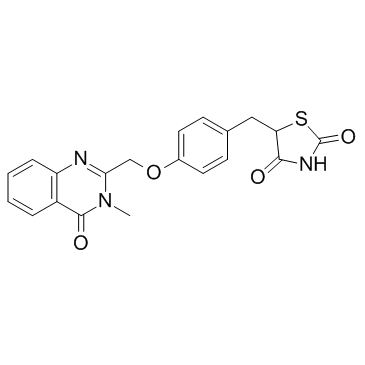199113-98-9
| Name | 5-[[4-[(3-methyl-4-oxoquinazolin-2-yl)methoxy]phenyl]methyl]-1,3-thiazolidine-2,4-dione |
|---|---|
| Synonyms |
NNC-61-0645
Balaglitazone NN2344 DRF-2593 Balaglitazone [INN] |
| Description | Balaglitazone is a selective partial PPARγ agonist with an EC50 of 1.351 μM for human PPARγ. |
|---|---|
| Related Catalog | |
| Target |
PPARγ:351 nM (EC50, Human PPARγ) |
| In Vitro | Balaglitazone is a selective partial PPARγ agonist with an EC50 of 1.351 μM[1]. Balaglitazone (5-100 μM) has equal cytotoxicity towards K562 and K562/DOX cells. Balaglitazone decreases doxorubicin cytotoxicity in K562 and K562/DOX cells, with IC50s of 0.117 μM and 0.53 μM, respectively. Balaglitazone reverses multidrug resistance (MDR) in K562/DOX cells. Balaglitazone (25 µM) increases Rh123 accumulation in K562/DOX cells, but does not increases MFI in K562 cells. Balaglitazone downregulates P-gp expression in K562/DOX cells, and such effects are via upregulation of PTEN in K562/DOX cells, and be abolished by PTEN inhibition[2]. |
| In Vivo | Balaglitazone (3 mg/kg, p.o.) shows antihyperglycaemic activity in fully diabetic and insulin resistant db/db mice, and is more potent than the full PPARγ agonist rosiglitazone[1]. Balaglitazone (10 mg/kg, p.o.) suppresses overall glucose, decreases insulin levels, and increases bodyweight in male diet-induced obese rats, and such effects are equal to that of 30 mg/kg pioglitazone[3]. |
| Cell Assay | MTT assay is used for cell viability analyses. Briefly, K562 and K562/DOX cells are seeded in a 96-well plate in RPMI-1640 medium supplemented with 10% FBS at the density of 2 × 104 cells/well. After 24 h incubation, various concentrations of doxorubicin (DOX) with or without balaglitazone are diluted in RPMI-1640 medium (without FBS) and added into each well. Experiments for each group are performed in triplicates and with a blank control. After 48 h of treatment, the medium is removed and 200 μL of RPMI-1640 medium supplemented with 10% FBS and 10% MTT (5 mg/mL) is added. After incubation for another 4 h, the reduced intracellular formazan product is dissolved by replacing 100 μL of RPMI-1640 medium with the same volume of dimethyl sulfoxide (DMSO). Absorbance values are measured at 570 nm with a micro plate reader. The half maximal inhibitory concentration (IC50) of each experiment is calculated. The resistance fold (RF) is calculated by dividing the IC50 value of treatment in resistant cells by the IC50 value of treatment in corresponding parental cells[2]. |
| Animal Admin | Antihyperglycaemic effects of balaglitazone and rosiglitazone are assessed in adult male diabetic db/db mice. At 14 weeks of age, animals are randomised according to fasting blood glucose into 11 groups (n = 6). Mice are dosed orally once daily for 9 days with vehicle (0.2% carboxymethyl cellulose (CMC) + 0.4% Tween-80 in saline) or increasing doses of either balaglitazone (0.1; 0.3; 1.0; 3.0; 10.0 mg/kg/day) or rosiglitazone (0.2; 0.6; 2.0; 6.0 mg/kg/day). After 7 days of treatment, plasma samples obtained in the morning (between 8:00 and 10:00 AM) are analysed for glucose and insulin. After 9 days of treatment, animals are exposed to an oral glucose tolerance test (OGTT; 3.0 g/kg). The resulting area under the curve is calculated for each of the doses[1]. |
| References |
| Molecular Formula | C20H17N3O4S |
|---|---|
| Molecular Weight | 395.43200 |
| Exact Mass | 395.09400 |
| PSA | 119.08000 |
| LogP | 2.68250 |
| Storage condition | -20°C |
| Hazard Codes | Xi |
|---|

